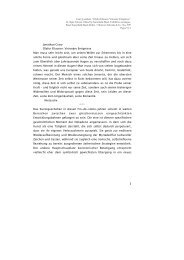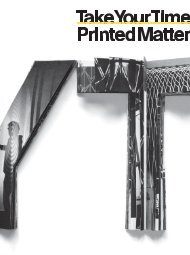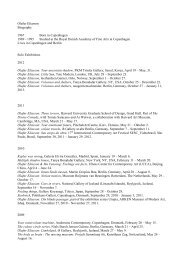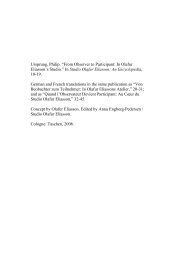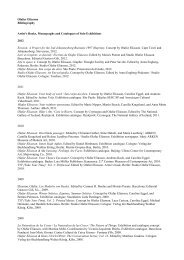Studio Olafur Eliasson
Studio Olafur Eliasson
Studio Olafur Eliasson
You also want an ePaper? Increase the reach of your titles
YUMPU automatically turns print PDFs into web optimized ePapers that Google loves.
Writings<br />
In 2009 <strong>Eliasson</strong> introduced a further element into the studio: the<br />
school. 6 “It’s hard to imagine the studio without the school,” <strong>Eliasson</strong><br />
notes, “the life of the Institute supports and amplifies the diversity<br />
of the studio and vice versa.” The fundamental difference, he explains,<br />
“is that I often focus on where ideas come from when talking with<br />
the students about their work whereas in the studio I mostly focus<br />
on where ideas will go.” The next afternoon I attend an informal<br />
seminar run by <strong>Eliasson</strong> with the school’s two co-directors, Eric<br />
Ellingsen and Christina Werner, which centers on a student<br />
exhibition based on a recent trip with the students to Iceland set to<br />
take place in a weeks’ time. Some of the students want to build a<br />
pool on the top floor of the studio where they can verbally share their<br />
Icelandic experiences with visitors to the exhibition. Given the<br />
timing, a very limited budget, and the general lack of a palpable sense<br />
of enthusiasm from the students, <strong>Eliasson</strong> doesn’t feel it’s a very<br />
practical solution, and concludes a lengthy explanation by saying,<br />
“and anyway, it sounds a little too arty.” Another student suggests<br />
that fabricating a book using the photographs generated by the trip<br />
and then sitting the books either on tables placed around the<br />
exhibition or hanging them from cord suspended from the ceiling<br />
would be a more appropriate means of communicating their<br />
collective experiences. <strong>Eliasson</strong> readily agrees. Further ideas are<br />
raised in rapid succession by different students—almost exhaustively<br />
so—and by the time of the seminar’s close the situation is even<br />
more inconclusive than it was at the beginning.<br />
An example of how much feedback there is between the school and<br />
the studio—that is, how effective <strong>Eliasson</strong>’s process of incorporating<br />
the elements he requires to produce his work—comes with the<br />
exhibition “Innen Stadt Außen” at Martin-Gropius-Bau in the spring<br />
and summer of 2010, curated by Daniel Birnbaum. Caroline Eggel<br />
from <strong>Studio</strong> <strong>Olafur</strong> <strong>Eliasson</strong> was the museum’s key curatorial conduit<br />
66<br />
<strong>Studio</strong> <strong>Olafur</strong> <strong>Eliasson</strong><br />
to the studio—introducing a further skill into the studio’s fabric. 7<br />
The relationship the exhibition triggers between the city and the<br />
museum was tested out on a number of occasions by studio staff and<br />
by the students. One of the school’s experiments with the body in the<br />
city took place in a class in January 2010. A mirror—a vital element<br />
in <strong>Eliasson</strong>’s practice in general and in the projects taking place<br />
outside Martin-Gropius-Bau in particular—was used by students to<br />
navigate their way around a part of Berlin. Later, during the<br />
exhibition’s run, the school also hosted a three-day space activism<br />
marathon with architects, artists, activists, urbanists, historians,<br />
and skate park designers. 8 Ellingsen meets me in the Model room as<br />
<strong>Eliasson</strong> and I conclude our interview, and he explains what place<br />
the school has within the overall framework of the studio. Ellingsen<br />
clarifies why the school is called the Institute for Spatial Experiments,<br />
“Being here—inside the larger studio—really involves the<br />
students conducting a spatial experiment every day as they negotiate<br />
their way through Berlin and around [the studio]” once they<br />
arrive. “One thing that really interests me,” Ellingsen continues,<br />
“is the way <strong>Olafur</strong> conducts his own spatial experiments by<br />
choreographing himself around the studio and allowing it to in<br />
turn choreograph him.”<br />
The next day I go to see “Innen Stadt Außen” and realize how experiencing<br />
the exhibition, the studio, and the school simultaneously, is<br />
crucial to a fuller understanding of all three elements’ dynamism.<br />
“Innen Stadt Außen” replaces the smoothness of “Take your time:<br />
<strong>Olafur</strong> <strong>Eliasson</strong>” at SFMOMA (2007) and MoMA and MoMA PS1<br />
(2008) with a more guttural relationship to the building and a fully<br />
textured dialogue with the city. The exhibition consists of a<br />
number of dynamic, overlapping platforms: a large exhibition filling<br />
a portion of Martin-Gropius-Bau, with most works produced for<br />
a particular space in the museum; a series of interventions in the city;<br />
and the re-siting of The blind pavilion (2003) on Peacock Island<br />
67



